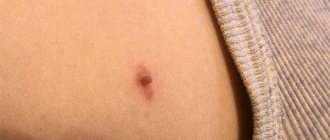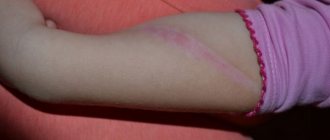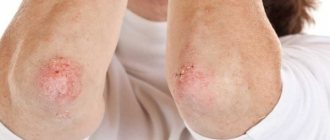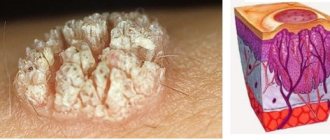External beauty and attractiveness in modern life are becoming not only desirable, but also a necessary attribute of creating a positive image. Fashion is changeable, and piquant spots and warts on the face and body, so popular in past centuries, are now perceived as a significant drawback that spoils one’s appearance. Moreover, they are not as harmless as they seem at first glance.
A wart, scientifically called a papilloma, does not appear on the body just like that. In ancient times, the cause of the appearance of papillomas was considered to be the evil eye, frogs, and much more. But only now, with the advent of modern molecular diagnostic methods, has it become clear: the cause of papillomas is the human papillomavirus (HPV).
Today, more than 100 types of HPV are known.
It is reliably known that HPV type 2 primarily affects the skin, causing the appearance of warts, and HPV 6, 11, 16, 18, 30, 31, 33, etc. gravitate to the mucous membranes. The human papillomavirus has long been considered the cause of only skin and genital warts, and only relatively recently have the oncogenic properties of papillomaviruses been discovered - their ability to cause cancer and, first of all, cancer of the genital organs in both men and women.
Based on long-term research, doctors have created a classification of HPV according to its oncogenic activity:
- “High-risk” HPV types (primarily 16, 18, 31 and 45). Increase the risk of precancerous diseases and genital cancer.
- “Low risk” HPV types (mainly 6 and 11). They cause the appearance of condylomas, but are not associated with precancerous diseases and cancer of the genital organs.
The presence of “high-risk” HPV in the body increases the likelihood of developing cancer by 60 times.
What are warts
First you need to understand what warts are. In essence, it is a skin disease that is characterized by the appearance of small formations. The size of such formations ranges from 1 mm to 1 or more centimeters.
The cause of warts is viral. They can be passed from person to person through a simple handshake or through the use of objects that have been used by a sick person. The incubation period can last several months. So when warts form on your body, it may be very difficult for you to remember who might have “given” them to you.
It must be said that there are different types of warts, so the attitude towards them should be extremely delicate. They can be located on the back of the hands, on the face, and even on the scalp. On the feet, warts are usually found on the soles. If they are painless on the arms, then on the legs they can cause a lot of inconvenience. Their formation can be promoted by sweating feet and shoe pressure.
A special place is occupied by juvenile warts that occur during adolescence. Typically these warts are small in size and are located on the hands and face. For any type of wart, you should consult a doctor to rule out the possibility of any other skin diseases.
Thus, genital warts are sometimes mistaken for warts, requiring consultation with a venereologist and urologist. Any new growth on the skin should require maximum attention. It happens that a tumor on the skin is mistaken for a wart, and this is extremely dangerous, especially if you are going to remove it. In this case, you should not turn to folk remedies!
Such procedures should only be carried out by a professional doctor, first making sure that he is dealing with a wart. Not all warts are recommended to be removed; this method is used as a last resort: if the wart causes discomfort or bleeds, if the wart causes aesthetic discomfort, if the wart has reached a large size, if it is growing.
Otherwise, it is better to treat warts. Treatment should be carried out by a doctor, and you should be monitored by him throughout the entire treatment period. It must be said that improper treatment can contribute to the degeneration of a wart into a malignant tumor. Therefore, contact only specialists.
Wart on the back, face, nose - how to treat
These are special areas where the skin is delicate and sensitive. It is necessary to remove papillomas here with extreme caution so that there are no scars left (especially when it comes to the face area). The first stage of treatment is medication; a dermatologist may prescribe a gentle ointment, which should be used at night. The child may also be prescribed medications that stimulate the immune system. To remove papillomas on the face or back, specialists from Meditsina JSC (academician Roitberg’s clinic) recommend using laser therapy. This will allow you to avoid scarring after the procedure.
Types of warts
Warts are diagnosed more often in childhood and adolescence, but can also occur in adults. In medicine, the following types of warts are distinguished:
- Simple/vulgar. The most common type of skin tumor, in 70% of cases it is diagnosed in school-age children. Most often, warts of this type appear on the hands, but they can also be present on the edges of the lips and on the neck. Simple warts are distinguished by the presence of one largest, “mother” wart - if it is removed, then the smaller tumors disappear.
- Flat/youthful. They are rare - only up to 4% of diagnosed cases. They are located on the back of the hands, along the edges of the lips, on the head of the penis, and on the oral mucosa.
- Palmoplantar. They appear in places where there is the most active pressure from uncomfortable shoes. Diagnosis of this type of wart is often difficult, because a specialist must differentiate the neoplasm in question from corns and calluses.
- Thread-like. It has a specific appearance - a small “tail” made of thin leather, there can be many of them and they are always arranged in a “cluster”. Most often found in the armpits, neck, and under the breasts/breasts.
Methods for removing warts on the body and hands directly depend on what type of tumor will be diagnosed in the patient.
It is worth knowing one more feature of warts - they do not have any one exact description of “appearance”. For example, a plantar wart may be a small rounded lump with a dark center, but a simple wart is a growth on the skin that has a heterogeneous structure. The easiest way to answer the question “what does a wart look like” is if it is a thread-like type - an “icicle” appears on the skin, not causing pain or irritation. It is noteworthy that frequent rubbing of a wart leads to its inflammation and irritation - it becomes red and can cause pain.
Prevention of warts
Preventive measures are aimed at strengthening the immune system:
- taking vitamin complexes;
- good nutrition;
- physical activity;
- walks in the open air;
- limited stay in public places (if possible).
The answer to the question of how to remove warts from children in the least traumatic and effective way will be answered by the doctors of the SM-Doctor clinic. A dermatologist will quickly and objectively make a diagnosis and prescribe treatment. Remember that removing tumors on your own is dangerous for the child’s health.
Where do warts come from?
It's all due to the human papillomavirus (HPV), which is most often transmitted through direct contact with a wart or personal belongings of an infected person. Four of the several dozen types of HPV are responsible for the appearance of warts on the skin.
HPV can easily be called “cunning”. A person may not suspect for a long time that he has become the owner of HPV.
After infection, the virus is localized in the upper layer of the epidermis and may not make itself known for a long time. But as soon as the protective mechanisms weaken, the virus becomes active and manifests itself in the form of one or more warts.
From the moment of infection to the appearance of skin formations, it can take from a week to several months.
How does the virus manifest itself?
An important circumstance is that clinical manifestations of HPV are not detected for quite a long time. Focusing on a long asymptomatic period, one should not underestimate the danger of human papillomavirus infection. Already today in the United States, infection caused by HPV is the most common viral disease, predominantly sexually transmitted (in our country, large-scale studies in this direction have not yet been conducted). Plus, HPV damage to the cervix, even in the presence of clinical manifestations, often goes undetected for a long time.
Infection with the human papillomavirus usually occurs through close contact with the source of infection. HPV can be transmitted with scales peeled off with papillomas during sexual play with hands, during sexual intercourse, and when women use hygienic tampons, it can be carried from the external genitalia into the vagina, onto the cervix. Infection of newborns during childbirth is possible.
Each wart, papilloma or condyloma (these are just different names for the same disease, differing only in the place of manifestation of the tumors) is a reservoir for the human papillomavirus. This virus also accumulates in the tissues surrounding the tumor, which can cause changes in the DNA of epithelial cells of the skin or mucous membranes of the genital organs, resulting in the development of precancerous conditions.
Papillomas manifest themselves as papillary growths protruding above the surface of the skin or mucous membrane, most often have a thin stalk, and sometimes a wide base. They can take on bizarre shapes that look like hairs, cauliflower or a cockscomb.
Locations
Which doctor to contact for warts depends directly on the location of the growths.
Depending on the variety, warts can grow all over the body, and in particular:
- on the leg and arm, on the foot;
- in the armpit area, under the breasts and on its surface;
- on the face, neck and head;
- on male and female genital organs;
- on the mucous membrane of the vagina, esophagus, larynx;
- in the mouth. on the tongue and inner surface of the cheeks and lips;
- on the body under clothes.
Diagnosis of warts
The main diagnostic method is to examine the patient's face for the presence of warts on the lips and oral mucosa.
To confirm or refute the presence of HPV, it is enough to take tests:
- ✓ Blood tests for antibodies
- ✓ To conduct a histological examination (biopsy), a small part of the tumor is taken for analysis
- ✓ The PCR technique allows you to detect the genetic material of a pathogen with one hundred percent probability
Before getting rid of the growth, you should visit an oncologist.
A specialist will use dermatoscopy to determine the condition of the wart to rule out signs of malignancy.
Reasons for appearance
It is very easy to contract the human papillomavirus (HPV).
It is enough to have close contact with a person who has growths on the skin.
However, the disease does not appear immediately, and warts may not begin to grow until several months or years after infection.
Factors influencing HPV activity:
- weakened immunity;
- exacerbation of chronic diseases;
- stress;
- malnutrition;
- bad habits;
- passive lifestyle.
Causes of warts
The main cause of warts in children is the papilloma virus.
Children and adolescents become infected with this pathogen through contact through household items, personal hygiene items, clothing and underwear. Infection occurs in public places, in transport, on playgrounds. It is possible to transmit microorganisms from mother to child during pregnancy. Once on the skin, the virus enters the body through microcracks and wounds. The disease may not manifest itself in any way for a long time. The activation of microorganisms and the appearance of growths occurs under the influence of a number of factors:
- weakened immunity;
- hormonal changes during adolescence;
- unbalanced diet;
- avitaminosis;
- sedentary lifestyle;
- lack of personal hygiene;
- stress, chronic fatigue;
- wearing uncomfortable shoes (relevant for plantar warts).
Important! Neoplasms appear mainly in weakened children with weak immune systems.
Why you need to get rid of warts
For those who are still unsure whether to remove warts, it is important to know the following.
- First, warts are contagious. To do this, direct contact with the wart or personal hygiene items of its carrier is sufficient.
- Secondly, warts tend to “conquer territory,” that is, spread to healthy areas of the skin. This process is called autoinoculation (self-infection).
Obviously, it is easier to treat warts in the early stages of the disease, which will save time, effort and money in the future. Moreover, in pharmacies you can purchase products for self-removal of warts.
Tips for parents
To avoid the formation of warts in children, teach your child hygiene, the use of personal soap and towels from childhood. Parents should monitor how correctly and carefully the child follows their recommendations. Hand washing is the first thing a child should do after walking outside and before eating. It is necessary to provide your child with healthy nutrition. It should consist of products containing calcium, fluorine, and iron. Include fermented milk products, fish, cereals, vegetables, and fruits in your diet. Cereals such as pearl barley and oatmeal. Food should contain a full range of vitamins and microelements.
Walking in the fresh air and playing sports are integral elements of a child’s life. This is what will help strengthen the baby’s immunity. If a child is injured, for example, falls and a wound forms, treat it with an antiseptic. Minimum stress – maximum benefit for the baby. If a wart appears, make an appointment with a pediatric dermatologist. Do not self-medicate, this may make the situation worse.
When to see a doctor
- if the wart quickly changes shape, color, or all together;
- if the wart has an uneven color;
- if the boundaries of the wart are blurred (in this case, most likely, it is not a wart);
- if the wart hurts or is constantly injured (this increases the risk of it degenerating into something more serious);
- if the number of warts gradually increases;
- if the wart bleeds or itches;
- if a wart has formed in the genital area.
The difference between a wart and keratoses and cancer
Keratosis may be similar in appearance to melanoma (a type of skin cancer).
Melanoma can begin as a warty growth or as a seborrheic keratosis.
A dermatologist can distinguish them from cancer.
To exclude an oncological process, a biopsy is performed.
The peculiarity of seborrheic keratosis is that the formation is waxy, flat, and there is no pain when touched or at rest.
With cancer, a growth similar to a keratosis may change shape or color.
In this case, you will need to consult a specialist.
Which doctor treats warts in children and adults
If growths appear on any part of the body, you should contact a doctor who specializes in the treatment of skin diseases - a dermatologist.
- It is he who conducts the examination and decides whether further diagnostics are necessary (blood test, PCR test, biopsy).
- In some doubtful cases, when a wart has signs of a malignant tumor, a dermatologist may recommend consulting an oncologist or dermato-oncologist.
- In most cases, the doctor decides to remove the wart, after which its tissue is sent for histological examination to ensure that there are no malignant signs.
- Warts on the mammary glands in women can cause breast cancer and require examination by a mammologist.
Contraindications to laser treatment
- infections and exacerbation of chronic pathologies;
- diabetes mellitus in the stage of decompensation;
- epilepsy and mental disorders;
- history of oncological pathologies;
- pregnancy and lactation;
- exacerbation of herpes.
| Cost of removing plantar warts | |
| Plantar warts up to 5 mm | 2950 rub. |
| Plantar warts from 5 to 10 mm | 3750 rub. |
| Plantar wart from 10 mm to 3 cm | 4900 rub. |
Sign up for a consultation
Wart removal
Removing warts is a radical method and is carried out in several ways. Warts can be removed using a laser. Along with this, cryotherapy and electrocoagulation methods are used. You can effectively remove warts using homeopathic medicines. Each method has its own strengths and weaknesses.
When choosing a method for removing a wart, the doctor is usually guided by the location of the wart on the body. Thus, laser removal can leave behind scars. Scar formation is sometimes observed after using the Surgitron device. Therefore, it is the doctor who must choose the method for removing warts: depending on where the warts are located.
Cryotherapy and electrocoagulation are gentle methods for removing warts. Electrocoagulation is carried out using a special device that uses high-frequency current. As a result of the use of this device, the temperature of the tissue increases and the wart is destroyed, resulting in the death of the virus.
Cryotherapy is also cauterization, but only with liquid nitrogen. The procedure is quite painless and does not leave any scars. Speaking about these two methods, it is worth noting that their use eliminates contact with blood, which is extremely important. You can only trust a doctor with experience in this field to remove warts.
After removing warts, you need to think about how to avoid getting this infection again. Under no circumstances should warts be torn off or tied with a thread at the base so that they fall off on their own! Such unreasonable behavior can lead to serious health problems - for example, the resulting wound can become infected, and due to the tightening of the base of the tumor, blood flow can be disrupted.
A dermatologist or cosmetologist will tell you how to get rid of warts on the hands of children and adults, what procedures will help you forget about tumors on the body and face - you can contact any of these specialists. There are three main methods of getting rid of warts:
- Laser therapy. Typically, this method is used to remove warts in the most tender and painful places, or if the patient wants to avoid scarring. Removing warts on the face with a laser is the optimal solution, since this procedure is painless, does not require a long recovery period, and after it there are no scars left on the skin.
- Cryodestruction. This involves the use of liquid nitrogen, which literally burns out the tumor without leaving marks on the skin, although in some cases a small scar is possible. After removing warts with liquid nitrogen, the patient will need to avoid being in direct sunlight; in the future, a small whitish spot may remain at the site of the procedure.
- Drug therapy. It is used in conjunction with the above methods. There are a lot of drugs that have a local effect and help to destroy the wart more quickly. The most effective remedy for warts is celandine extract, which is applied pointwise to the growth. You should not use the celandine plant yourself to treat warts - if its juice gets on healthy skin, it causes severe burns.
Getting rid of this type of skin tumor should be comprehensive. It’s not enough to visit a doctor and find out what causes warts on your fingers or face; you must follow all the prescriptions and recommendations of a specialist. Even with proper treatment, relapses of the disease are recorded quite often - in 40-50% of cases, warts reappear.
More information about what warts are, which doctor to contact to treat a plantar wart and what is meant by the term “general therapy for human papillomavirus” can be found on the pages of our website.
Treatment
Treatment of warts in children is carried out under the supervision of a doctor. The specialist can prescribe both removal of the papilloma and select an intensive course of treatment consisting of medications. There are cases when warts on a child’s leg are treated with a special patch, solution, or using folk remedies. Take into account! Folk remedies act as a preventive or additional method to the main drug treatment, but do not act as a separate way to get rid of warts.
Folk remedies
There are vegetables that have the same effect (freezing, relieving inflammation, cauterization) as medications and various procedures. A wart on a child’s leg or hands – what can be used:
- potato. Use it to make a compress at night;
- celandine. The juice is applied to the wart three times a day;
- celandine grass. It is mixed with medical Vaseline and applied to the site of the disease;
- garlic. Wrap in a sterile napkin and apply to the papilloma for 20 minutes;
- Apple vinegar. It is mixed with water 2:1, a swab is applied to the affected area;
- aloe. Apply the sheet to the wart, wrap the area with a bandage, change the sheet after it has completely dried;
- honey and onion, mix honey with onion juice. This method is not recommended if you are allergic to honey;
- tomato. Apply tomato pulp to the wart once a day.
Wormwood oil helps well; it can also be mixed with olive oil. Lubricate the area 4 times a day. The use of any medical product must be under the supervision of a physician. Take into account! If, after using folk remedies, the growth has dried out and fallen off, there is no guarantee that the wart has been completely eradicated; it may remain in the middle, so it will soon appear again.
Is it possible to remove warts yourself?
Warts can be removed at home yourself, but only after diagnosis by a specialist.
There are special burning pharmaceutical products that can remove the growth after the first use:
- “Cryopharma” operates on the principle of liquid nitrogen, destroys tissue and the wart disappears within 1–2 weeks after cauterization with the solution;
- “Super cleanser” based on plant juice has a cauterizing and necrotizing effect and is applied daily until the growth completely disappears;
- “Ferezol” - a phenol-based solution corrodes the wart and disinfects it, which is applied to the growth several times as it dries and left for 20-40 minutes, the procedure is repeated after a week;
- salicylic acid and patches soaked in it gradually soften the warts, after which they fall off; treatment must be continued until the growth falls off along with the root.
These drugs are toxic and can cause burns to the tissue around the wart, so they must be used with caution. It is not advisable to remove warts at home in places with particularly delicate and sensitive skin (on the face, neck, mammary glands and genitals). You also need to ensure that the wart is completely gone and that no root or any other part of it remains. The ability of warts to reproduce is so great that even a small piece of tissue can become a source of infection in healthy areas of the dermis.
When using pharmaceutical drugs, you must strictly follow the instructions for their use and pay close attention to contraindications. Most of them are prohibited for use in children, pregnant and breastfeeding women.
Warts are external manifestations of an unsatisfactory internal state of the body. It is important not just to get rid of the symptoms of the disease, but to continuously fight the virus. The human immune system is able to independently cope with the causative agent of the disease if it is given all possible help. To do this, it’s enough just to lead a healthy and active lifestyle, strengthen the body with sports and healthy food.
Strengthening the immune system
Modern medicine has not yet learned to kill viruses. But an important fact is that HPV carriage is not lifelong. In addition, medicine has a small number of means at its disposal that allow it to remove some of the viruses from the body. The use of these drugs is fully compatible with immunomodulatory therapy.
The amount of virus in the body is directly related to the state of the body’s immunity - the better the immunity, the less virus. Therefore, the most promising way to reduce the concentration of HPV in the body is to strengthen the immune system. For this purpose, a separate course of treatment is carried out, after which the person begins to feel much better.
Finally, there are very effective preparations for topical use - creams, gels, sprays that increase local immunity and reduce the concentration of the virus in the affected tissues.
Complications
Anogenital warts under certain conditions (for example, in case of infection with sexually transmitted infections, decreased general and/or local immunity) can increase in size and grow, thereby worsening a person’s sexual life and significantly reducing his quality of life.
In addition, inflammation and suppuration of anogenital warts, as well as their ulceration, may develop due to prolonged mechanical impact on them. In rare cases, their malignant degeneration is possible.
Clinical manifestations of warts on the lip
A wart on the lip does not appear the next day after the papilloma virus enters the body.
The incubation period can last from six months to several years.
This often occurs when the immune system malfunctions.
Having penetrated the skin or mucous membrane, the virus integrates its genetic material into human cells and thus begins to multiply.
As a result, characteristic neoplasms appear at the site of virus introduction.
The pathogen provokes warty growths, disrupting the processes of keratinization of the skin.
Oncogenic strains of papillomavirus change the genetic apparatus of cells in such a way that a malignant formation is formed.
Recommendations for patients with warts
- Since two thirds of cases resolve spontaneously within two years, warts can be observed without treatment. As old lesions resolve, new warts may appear. This is not a consequence of treatment failure, but is part of the natural history of HPV infection.
- Treatment often takes many weeks or months, so patience and persistence are necessary for therapy to be successful.
- Tools that have been used to remove warts, such as nail files and pumice stones, should not be used on healthy skin or by other people. For the same reason, if warts are located on areas of the skin that have hair, you should use depilatories or electric razors to remove hair in these areas, or not remove hair at all, thereby limiting the spread of warts.
- To monitor and evaluate the results of treatment, a repeated visit to the doctor is necessary. • If the patient carries out treatment on his own, he can schedule follow-up visits with the doctor at his own discretion.
Is it necessary to remove a wart on the lip?
Removal of the tumor is carried out if there are indications for this.
The growths sometimes disappear spontaneously.
Therefore, if the wart is small and does not cause much concern, then there is no need for removal.
The decision to excise the growth must be made by a specialist.
If a wart causes discomfort in the form of itching, burning, pain, grows, becomes inflamed, or changes in appearance.
If it has increased in size, changed shape and color, or is bleeding, then it must be removed by resorting to excision by one of the methods.
Removing a tumor at home is not safe.
As a result of incorrect actions:
- It may not be possible to remove the wart completely, which will cause its reappearance
- the risk of injury to healthy tissues that surround the growth increases
- scars and cicatrices may form
Wart treatment
Treatment of any growth on the lips begins with a medical examination and determining whether the growth is malignant.
Next, the doctor selects a method of therapy.
In case of a malignant form, the patient is referred to an oncologist, who will decide how to treat the patient.
Treatment of the disease is complex.
Treatment consists of the main stages: removal of the growth and drug therapy.
Removal of the tumor can be done in one of the following ways:
- ✓ Using pharmaceutical products
- ✓ In a medical institution where modern excision techniques will be used
- ✓ Folk remedies. The use of alternative medicine methods must be agreed with a doctor











